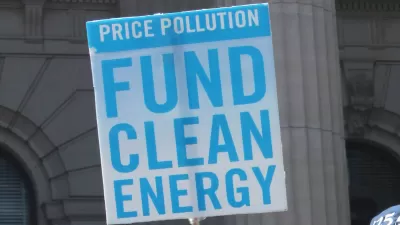The report heralds increased shuttering of coal-burning powered plants due to cheaper alternatives. Almost three-quarters of coal-burning power plants today are more costly to operate than renewable facilities. In six years, it jumps to 86 percent.

The name of the report, "The Coal Cost Crossover," released by Energy Innovation and Vibrant Clean Energy on March 24, conveys its conclusion: "the shifting economics of electricity generation may force utilities and regulators to ask difficult questions about what to do with assets that are losing their value," writes
Dan Gearino for InsideClimate News.
The report takes a point that has been well-established by other studies—that coal power, in addition to contributing to air pollution and climate change, is often a money-loser—and shows how it applies at the state level and plant level when compared with local wind and solar power capacity.
The key point ... : Building new wind and solar power capacity locally, defined as within 35 miles for the report, is often less expensive than people in those markets realize, and this is indicative of a price trend that is making coal less competitive.
One of the more interesting points that Gearino makes is about the role natural gas plays in the "energy transition" away from fossil fuels and towards renewable power.
The report's findings about the declining viability of coal plants are in line with previous studies, including one from March 2018 from BloombergNEF with the headline, "Half of U.S. Coal Fleet on Shaky Economic Footing."
William Nelson, a co-author of the BloombergNEF report, says he is leery of comparing the costs of building new wind and solar to the costs of operating existing coal plants because a coal plant is capable of running around the clock, which makes it a different type of resource than wind and solar unless there is large-scale battery storage.
More coal plants?
Nelson's point has to do with what is called capacity markets, "hav(ing) adequate generating resources to ensure that the demand for electricity can be met at all times," according to Direct Energy. This factor is slowing the transition to renewables, writes Iulia Gheorghiu in Utility Dive:
Coal resources receive revenue through the capacity market, which currently has rules that favor baseload generation and have "slowed the exit of uneconomic coal plants," according to Mike O'Boyle, one of the report's co-authors and an EI analyst.
The economics of supplying the capacity market is so strong that one regional transmission organization, PJM Interconnection, actually would like to see more coal plants built, adds Gheorghiu.
Based on [a "fuel security" report released November 2018], PJM supports more coal plants in their future projections for a variety of reasons, including the added capacity market revenues, which need "to be modified to be a bit more fair for renewables and other sort of new technologies to participate on equal footing with baseload generation," according to O'Boyle.
Support for renewables continues
On a related note to replacing coal power with renewable sources, Gallup released a poll on March 22 that found that most Americans support reducing fossil fuel use, including 80% of Democrats and 37% of Republicans, reports Justin McCarthy.
Support for greater emphasis on solar and wind energy has been stable since 2013, but support for more oil, natural gas and coal has fallen in that time.
Hat tip to Ned Ford.
FULL STORY: New Wind and Solar Power Is Cheaper Than Existing Coal in Much of the U.S., Analysis Finds

Alabama: Trump Terminates Settlements for Black Communities Harmed By Raw Sewage
Trump deemed the landmark civil rights agreement “illegal DEI and environmental justice policy.”

Study: Maui’s Plan to Convert Vacation Rentals to Long-Term Housing Could Cause Nearly $1 Billion Economic Loss
The plan would reduce visitor accommodation by 25% resulting in 1,900 jobs lost.

Planetizen Federal Action Tracker
A weekly monitor of how Trump’s orders and actions are impacting planners and planning in America.

Wind Energy on the Rise Despite Federal Policy Reversal
The Trump administration is revoking federal support for renewable energy, but demand for new projects continues unabated.

Passengers Flock to Caltrain After Electrification
The new electric trains are running faster and more reliably, leading to strong ridership growth on the Bay Area rail system.

Texas Churches Rally Behind ‘Yes in God’s Back Yard’ Legislation
Religious leaders want the state to reduce zoning regulations to streamline leasing church-owned land to housing developers.
Urban Design for Planners 1: Software Tools
This six-course series explores essential urban design concepts using open source software and equips planners with the tools they need to participate fully in the urban design process.
Planning for Universal Design
Learn the tools for implementing Universal Design in planning regulations.
Caltrans
Smith Gee Studio
Institute for Housing and Urban Development Studies (IHS)
City of Grandview
Harvard GSD Executive Education
Toledo-Lucas County Plan Commissions
Salt Lake City
NYU Wagner Graduate School of Public Service




























